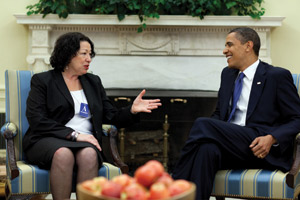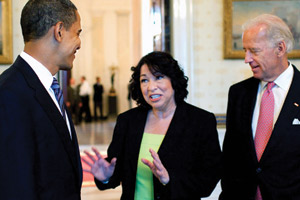
White House photo.
Monday kicks off the confirmation hearings for Sonia Sotomayor, and by all accounts, the event promises to be a snoozer. Members of the Senate Judiciary Committee will speechify about empathy and legislating from the bench. They’ll demand to know what Sotomayor thinks about Roe v. Wade or probe her reasoning in the infamous Connecticut firefighters case. And like all prospective justices, her answers will be unsatisfactorily vague. Republicans are no doubt longing to take swipes at President Obama’s first nominee, but they don’t have the votes to block her appointment, so they’ll probably pull their punches to avoid alienating Latino voters with gratuitous attacks. Sotomayor has also given them precious little material to work with.
But there is one question to which Sotomayor might have to provide a straight answer—and that could trigger some drama. Her response could shed light on what kind of a justice she’ll be and, at least in one respect, how she’ll differ from the man she’s replacing, Justice David Souter.
Sen. Arlen Specter (D-Pa.) plans to ask Sotomayor whether she would support televising Supreme Court oral arguments. It’s not a make-or-break issue, but it’s an important one. The court is one of the few places in government where cameras are absolutely verboten. The court doesn’t allow electronic recording devices and only recently started releasing audio from select arguments. To see the justices deliberate the crucial issues of the day, citizens must travel to DC and stand in line for hours in the hopes of securing one of the few available public seats. These practices render the court largely inaccessible to most Americans.
That’s why Specter is a major proponent of broadcasting oral arguments. He has introduced legislation several times that would force the court to open up its proceedings to cameras. In a June letter to Sotomayor, Specter waxed poetic about the value of transparency. He quotes Chief Justice William Howard Taft, who said, “Nothing tends more to render judges careful in their decision and anxiously solicitous to do exact justice than the consciousness that every act of theirs is subject to the intelligent scrutiny of their fellow men and to candid criticism.”
In his letter, Specter said he had tried to persuade the late Chief Justice William Rehnquist to allow the broadcast of oral arguments during Bush v. Gore, the case that decided the 2000 presidential election. Rehnquist said no. But much has changed since then. Rehnquist has been replaced by the young, telegenic John Roberts, who has said that he would keep an open mind on the subject of televised arguments. Justice Samuel Alito actually voted to allow cameras into the courtroom while on the Third Circuit Court of Appeals, a sign that he might belong to the TV-friendly camp. Justices Stephen Breyer, Ruth Bader Ginsburg, and John Paul Stevens have long suggested that they would support broadcasts, and the all-important swing voter, Justice Kennedy, has grudgingly conceded that cameras in the courtroom are “inevitable.”
Even so, the court, which can decide to allow cameras unilaterally, still has some holdouts. Justice Clarence Thomas opposed Specter’s bill in 2006. In February, Justice Antonin Scalia said at a public event that TV’s “30-second takeouts” would misrepresent what the court really does. “Why should I be a party to the miseducation of the American people?” he grumbled.
But by far the court’s biggest stick in the mud has been Justice Souter, who famously announced, “I can tell you the day you see a camera come into our courtroom, it is going to roll over my dead body.” Souter is a notorious technophobe. His New Hampshire farmhouse is full of books, but TV is outlawed. Not only does he eschew computers, emails, and answering machines, he wrote his opinions with a fountain pen. Deeply publicity shy, Souter was repulsed by the television coverage of his own confirmation hearing. Specter believes Souter’s retirement presents a great opportunity to revisit the camera question.
Sotomayor is an entirely different animal than Souter—she’s from the Bronx, after all—and actually has some experience with judging on camera. Back in 1991, the Federal Judicial Conference toyed with the idea of allowing cameras in all federal courtrooms for civil proceedings. It ran a three-year experiment, allowing cameras in six federal district courts and two circuit courts. One was Sotomayor’s. She hasn’t spoken publicly about the project, but the Federal Judicial Center reported that most judges were just fine with the cameras, and for the most part noticed little effect on proceedings. And most of the concerns the federal judges did have—that people wouldn’t testify or that jury privacy would be compromised—don’t apply to the Supreme Court, where there are no juries or skittish witnesses to spook.
Specter plans to ask Sotomayor about this experience, and whether she might agree with Justice Stevens’ view that Supreme Court TV is “worth a try.” Let’s hope she does. Otherwise, her perfunctory confirmation hearings may represent the first and last time the public really gets a good look at her. Which would be a shame because, while her written opinions may be a drag, Sotomayor is reportedly a firebrand on the bench. The sparks missing from her opinions—and her confirmation hearings—are likely to fly in oral arguments, when she’ll get to square off against some of the nation’s best litigators and her other brilliant colleagues. Sotomayor v. Scalia is something everyone should get to watch on TV.
















